Nursing Care During Total Hip Replacement
VerifiedAdded on 2022/12/18
|8
|2384
|44
AI Summary
This article provides information on the nursing care required during total hip replacement surgery. It covers preoperative care, including assessment and treatment considerations, as well as postoperative care and rehabilitation. Find study material and solved assignments on nursing care during total hip replacement on Desklib.
Contribute Materials
Your contribution can guide someone’s learning journey. Share your
documents today.
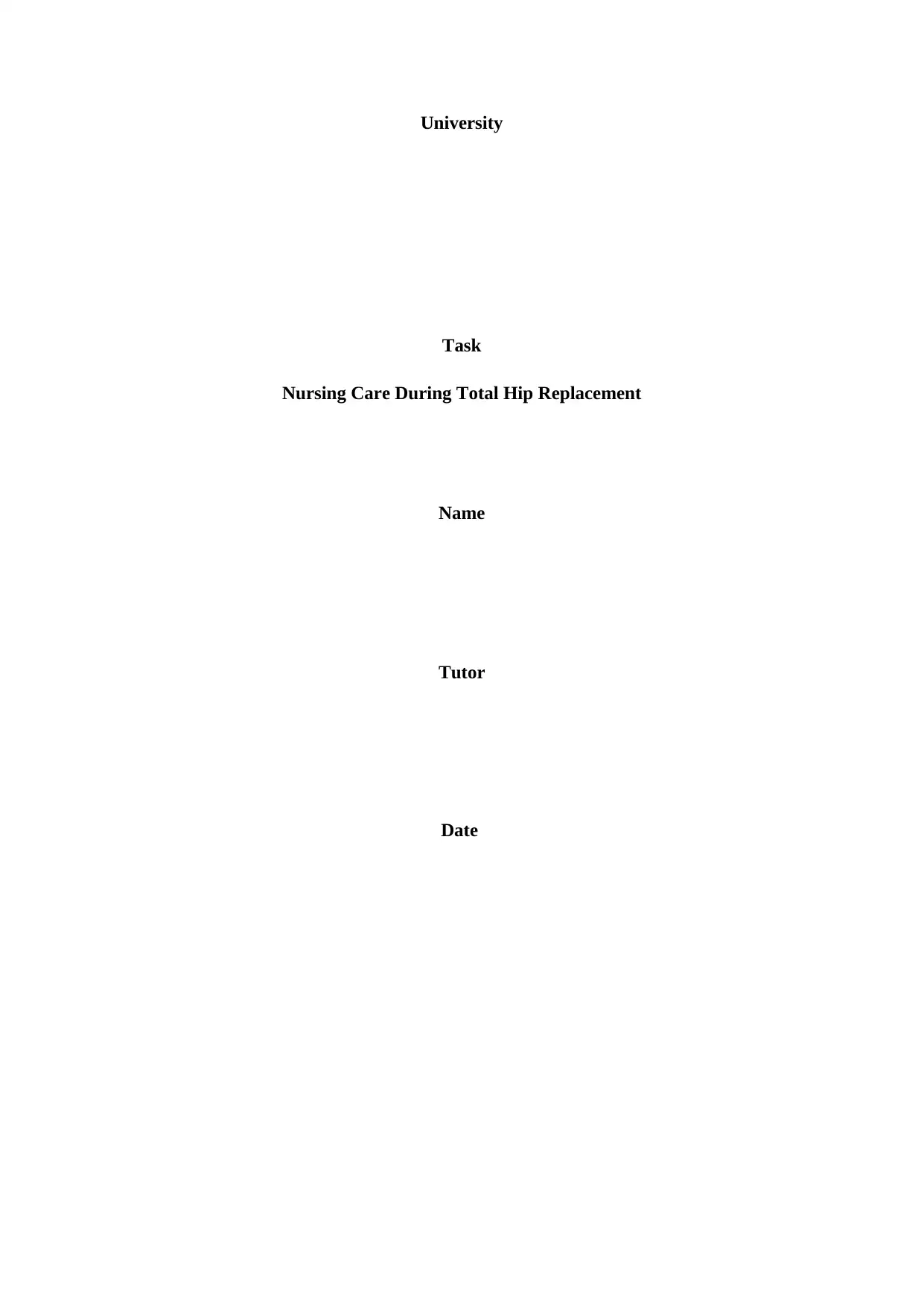
University
Task
Nursing Care During Total Hip Replacement
Name
Tutor
Date
Task
Nursing Care During Total Hip Replacement
Name
Tutor
Date
Secure Best Marks with AI Grader
Need help grading? Try our AI Grader for instant feedback on your assignments.
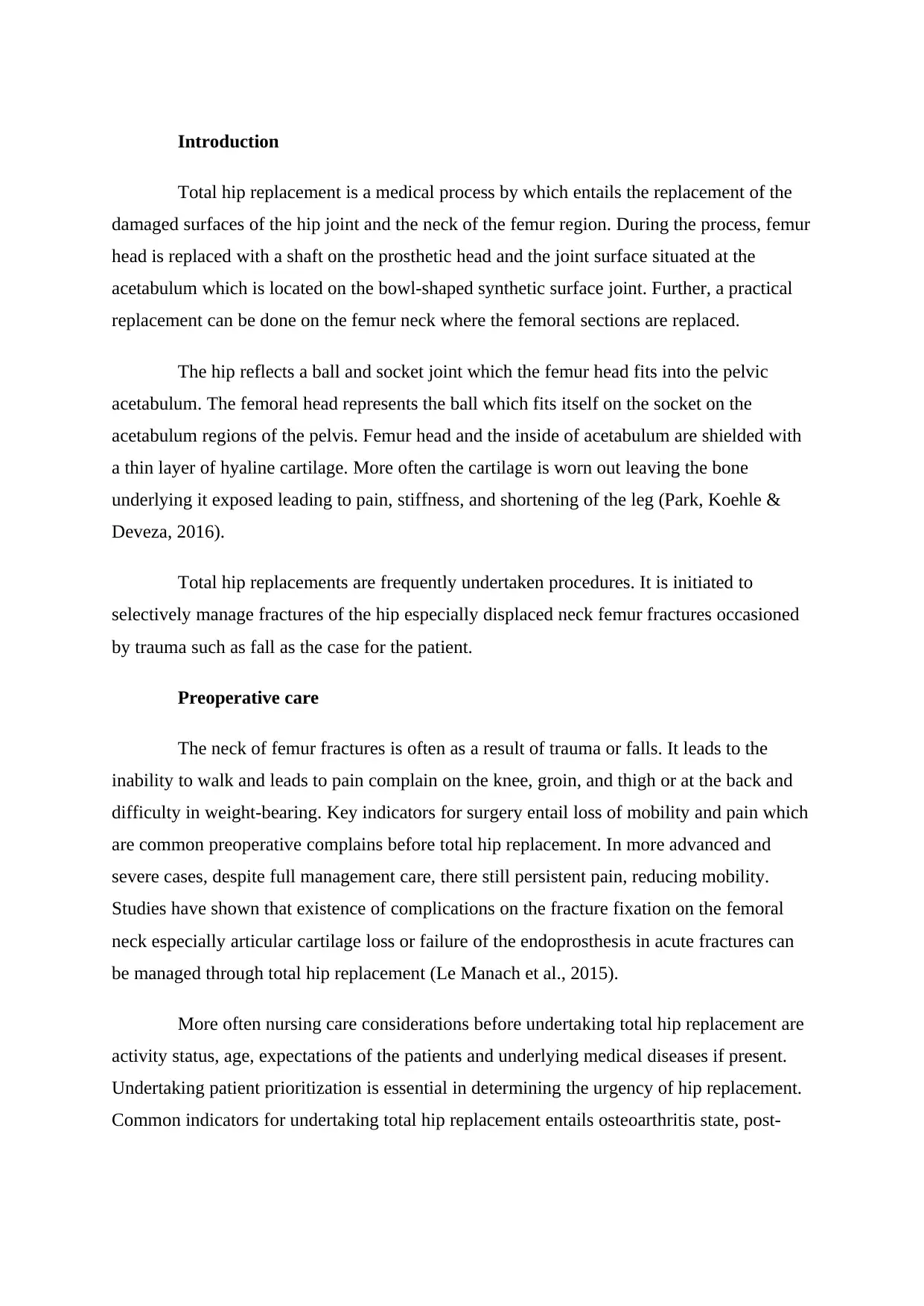
Introduction
Total hip replacement is a medical process by which entails the replacement of the
damaged surfaces of the hip joint and the neck of the femur region. During the process, femur
head is replaced with a shaft on the prosthetic head and the joint surface situated at the
acetabulum which is located on the bowl-shaped synthetic surface joint. Further, a practical
replacement can be done on the femur neck where the femoral sections are replaced.
The hip reflects a ball and socket joint which the femur head fits into the pelvic
acetabulum. The femoral head represents the ball which fits itself on the socket on the
acetabulum regions of the pelvis. Femur head and the inside of acetabulum are shielded with
a thin layer of hyaline cartilage. More often the cartilage is worn out leaving the bone
underlying it exposed leading to pain, stiffness, and shortening of the leg (Park, Koehle &
Deveza, 2016).
Total hip replacements are frequently undertaken procedures. It is initiated to
selectively manage fractures of the hip especially displaced neck femur fractures occasioned
by trauma such as fall as the case for the patient.
Preoperative care
The neck of femur fractures is often as a result of trauma or falls. It leads to the
inability to walk and leads to pain complain on the knee, groin, and thigh or at the back and
difficulty in weight-bearing. Key indicators for surgery entail loss of mobility and pain which
are common preoperative complains before total hip replacement. In more advanced and
severe cases, despite full management care, there still persistent pain, reducing mobility.
Studies have shown that existence of complications on the fracture fixation on the femoral
neck especially articular cartilage loss or failure of the endoprosthesis in acute fractures can
be managed through total hip replacement (Le Manach et al., 2015).
More often nursing care considerations before undertaking total hip replacement are
activity status, age, expectations of the patients and underlying medical diseases if present.
Undertaking patient prioritization is essential in determining the urgency of hip replacement.
Common indicators for undertaking total hip replacement entails osteoarthritis state, post-
Total hip replacement is a medical process by which entails the replacement of the
damaged surfaces of the hip joint and the neck of the femur region. During the process, femur
head is replaced with a shaft on the prosthetic head and the joint surface situated at the
acetabulum which is located on the bowl-shaped synthetic surface joint. Further, a practical
replacement can be done on the femur neck where the femoral sections are replaced.
The hip reflects a ball and socket joint which the femur head fits into the pelvic
acetabulum. The femoral head represents the ball which fits itself on the socket on the
acetabulum regions of the pelvis. Femur head and the inside of acetabulum are shielded with
a thin layer of hyaline cartilage. More often the cartilage is worn out leaving the bone
underlying it exposed leading to pain, stiffness, and shortening of the leg (Park, Koehle &
Deveza, 2016).
Total hip replacements are frequently undertaken procedures. It is initiated to
selectively manage fractures of the hip especially displaced neck femur fractures occasioned
by trauma such as fall as the case for the patient.
Preoperative care
The neck of femur fractures is often as a result of trauma or falls. It leads to the
inability to walk and leads to pain complain on the knee, groin, and thigh or at the back and
difficulty in weight-bearing. Key indicators for surgery entail loss of mobility and pain which
are common preoperative complains before total hip replacement. In more advanced and
severe cases, despite full management care, there still persistent pain, reducing mobility.
Studies have shown that existence of complications on the fracture fixation on the femoral
neck especially articular cartilage loss or failure of the endoprosthesis in acute fractures can
be managed through total hip replacement (Le Manach et al., 2015).
More often nursing care considerations before undertaking total hip replacement are
activity status, age, expectations of the patients and underlying medical diseases if present.
Undertaking patient prioritization is essential in determining the urgency of hip replacement.
Common indicators for undertaking total hip replacement entails osteoarthritis state, post-

traumatic arthritis, avascular necrosis, failure of the hardware and congenital hip dislocations
(Affatato, 2014).
Occurrences of contraindications which are key during surgery entail active
infection, sepsis, neuropathic joint, and malignant tumors. Other relative procedures entail
localized infection, insufficiency of abductor musculature, neurologic deficit and destruction
bone (Perez et al., 2016).
Common diagnostic procedures to be undertaken entail assessment with current
symptoms. Loss of motion, pain and functional impairments are important to consider.
Consultation with orthopedic surgeon often entails observation, subjective interview to
review pain complaints, previous history, and physical examination, such as standing.
Trendenberg tests, gait, supine, objective observation and motion ranges. Other special
investigations entail x-rays on the hip and CT scans (Iamthanaporn, Chareancholvanich &
Pornrattanamaneewong, 2015).
The pre-surgery review is undertaken to assess and determine the approach for
surgery. Surgical approaches can be anterior, anterior lateral, direct lateral, lateral trans
trochanteric approach, lateral approach, posterolateral and posterior approach. Various
approach can be applied as they determine soft tissue damage and key precautions for total
hip replacement (Lamo-Espinosa et al., 2015).
During pre-operative care, prescription of preoperative exercise is essential for the
improvement of hip surgery and is essential in improving the quality of life during the
preoperative phase. Studies and evidence have shown that educational and physiotherapy is
essential for patients with end-stage osteoarthritis (Gill & McBurney, 2013). A six-week
study on exercise and education indicated significant and improved pain and disability for
patients waiting for joint replacement care. Moreover, there were marked improvement on
knowledge, functional and social aspects (Saw, Kruger-Jakins, Edries & Parker 2015).
Assessment and treatment session during this phase is essential in the planning of
post-operative care after total hip replacement. Key beneficial effects entail declined length
of stay, lowered anxiety levels, increased levels of confidence and establishment of trusts
between the patient and physiotherapist early enough (Robertson, Warganich, Ghazarossian
& Khatod 2015). Further, it is essential in developing a patient-specific rehabilitation process
thereafter. Research studies have demonstrated that a mix of verbal explanation and written
(Affatato, 2014).
Occurrences of contraindications which are key during surgery entail active
infection, sepsis, neuropathic joint, and malignant tumors. Other relative procedures entail
localized infection, insufficiency of abductor musculature, neurologic deficit and destruction
bone (Perez et al., 2016).
Common diagnostic procedures to be undertaken entail assessment with current
symptoms. Loss of motion, pain and functional impairments are important to consider.
Consultation with orthopedic surgeon often entails observation, subjective interview to
review pain complaints, previous history, and physical examination, such as standing.
Trendenberg tests, gait, supine, objective observation and motion ranges. Other special
investigations entail x-rays on the hip and CT scans (Iamthanaporn, Chareancholvanich &
Pornrattanamaneewong, 2015).
The pre-surgery review is undertaken to assess and determine the approach for
surgery. Surgical approaches can be anterior, anterior lateral, direct lateral, lateral trans
trochanteric approach, lateral approach, posterolateral and posterior approach. Various
approach can be applied as they determine soft tissue damage and key precautions for total
hip replacement (Lamo-Espinosa et al., 2015).
During pre-operative care, prescription of preoperative exercise is essential for the
improvement of hip surgery and is essential in improving the quality of life during the
preoperative phase. Studies and evidence have shown that educational and physiotherapy is
essential for patients with end-stage osteoarthritis (Gill & McBurney, 2013). A six-week
study on exercise and education indicated significant and improved pain and disability for
patients waiting for joint replacement care. Moreover, there were marked improvement on
knowledge, functional and social aspects (Saw, Kruger-Jakins, Edries & Parker 2015).
Assessment and treatment session during this phase is essential in the planning of
post-operative care after total hip replacement. Key beneficial effects entail declined length
of stay, lowered anxiety levels, increased levels of confidence and establishment of trusts
between the patient and physiotherapist early enough (Robertson, Warganich, Ghazarossian
& Khatod 2015). Further, it is essential in developing a patient-specific rehabilitation process
thereafter. Research studies have demonstrated that a mix of verbal explanation and written

pamphlets is an essential way of undertaking health education. It is key in preoperative
physiotherapy before undertaking total hip replacements which are essential in improving
postoperative adherence (Barnes et al., 2018).
Undertaking a pre-operative assessment process is essential in planning of post-
operative care for patients. Benefits of undertaking these entail improved overall quality of
life and the psychological health state. Further, the development of patient-specific
rehabilitation program is taken into considerations. The fundamental aspects of therapy are
care of surgical process and general patient state. The wishes of the patient as to whether to
gain physical fitness or intends to recover physical activity needs to be undertaken while
establishing the post-care process.
Assessing with regards to subjective history, motion range, muscle power,
circulation, mobility, and function of the patient is critical. During the treatment phase,
covering aspects of education and advice, discharge plan, gait re-education on mobility and
stair climbing are vital aspects.
Postoperative care
The critical purpose of undertaking post-operative care is to address patient
functional aspects such as mobility and improving strength and motion aspects. This is an
essential process which kicks off as an aided process but the target is to enable the patient to
get to the functional status before discharge is undertaken. In cases where the patient can
have preoperative pathology, presentation of atrophy and lack of strength might be observed.
The surgery can have the potential of offering solution to joint problems, weakness of the
muscles which occur before surgery process. Undertaking an early rehabilitation process on
post total hip replacement on the neck of femur focuses on mobility, strength and pain
reduction is essential (Malek et al., 2016). Research studies have illustrated that patients can
improve tremendously through strengthening training program after total hip replacement.
Enhancing the post-operative rehabilitation process is essential in improving daily activities
and improving patient comfort leading to early discharge (Robertson et al., 2015).
Studies have demonstrated that initiating physiotherapy is essential in the prevention
of gait after total hip replacement and complications linked to the thromboembolic and
subluxation diseases. Further, physiotherapy is essential in increasing the mobility of the
physiotherapy before undertaking total hip replacements which are essential in improving
postoperative adherence (Barnes et al., 2018).
Undertaking a pre-operative assessment process is essential in planning of post-
operative care for patients. Benefits of undertaking these entail improved overall quality of
life and the psychological health state. Further, the development of patient-specific
rehabilitation program is taken into considerations. The fundamental aspects of therapy are
care of surgical process and general patient state. The wishes of the patient as to whether to
gain physical fitness or intends to recover physical activity needs to be undertaken while
establishing the post-care process.
Assessing with regards to subjective history, motion range, muscle power,
circulation, mobility, and function of the patient is critical. During the treatment phase,
covering aspects of education and advice, discharge plan, gait re-education on mobility and
stair climbing are vital aspects.
Postoperative care
The critical purpose of undertaking post-operative care is to address patient
functional aspects such as mobility and improving strength and motion aspects. This is an
essential process which kicks off as an aided process but the target is to enable the patient to
get to the functional status before discharge is undertaken. In cases where the patient can
have preoperative pathology, presentation of atrophy and lack of strength might be observed.
The surgery can have the potential of offering solution to joint problems, weakness of the
muscles which occur before surgery process. Undertaking an early rehabilitation process on
post total hip replacement on the neck of femur focuses on mobility, strength and pain
reduction is essential (Malek et al., 2016). Research studies have illustrated that patients can
improve tremendously through strengthening training program after total hip replacement.
Enhancing the post-operative rehabilitation process is essential in improving daily activities
and improving patient comfort leading to early discharge (Robertson et al., 2015).
Studies have demonstrated that initiating physiotherapy is essential in the prevention
of gait after total hip replacement and complications linked to the thromboembolic and
subluxation diseases. Further, physiotherapy is essential in increasing the mobility of the
Secure Best Marks with AI Grader
Need help grading? Try our AI Grader for instant feedback on your assignments.
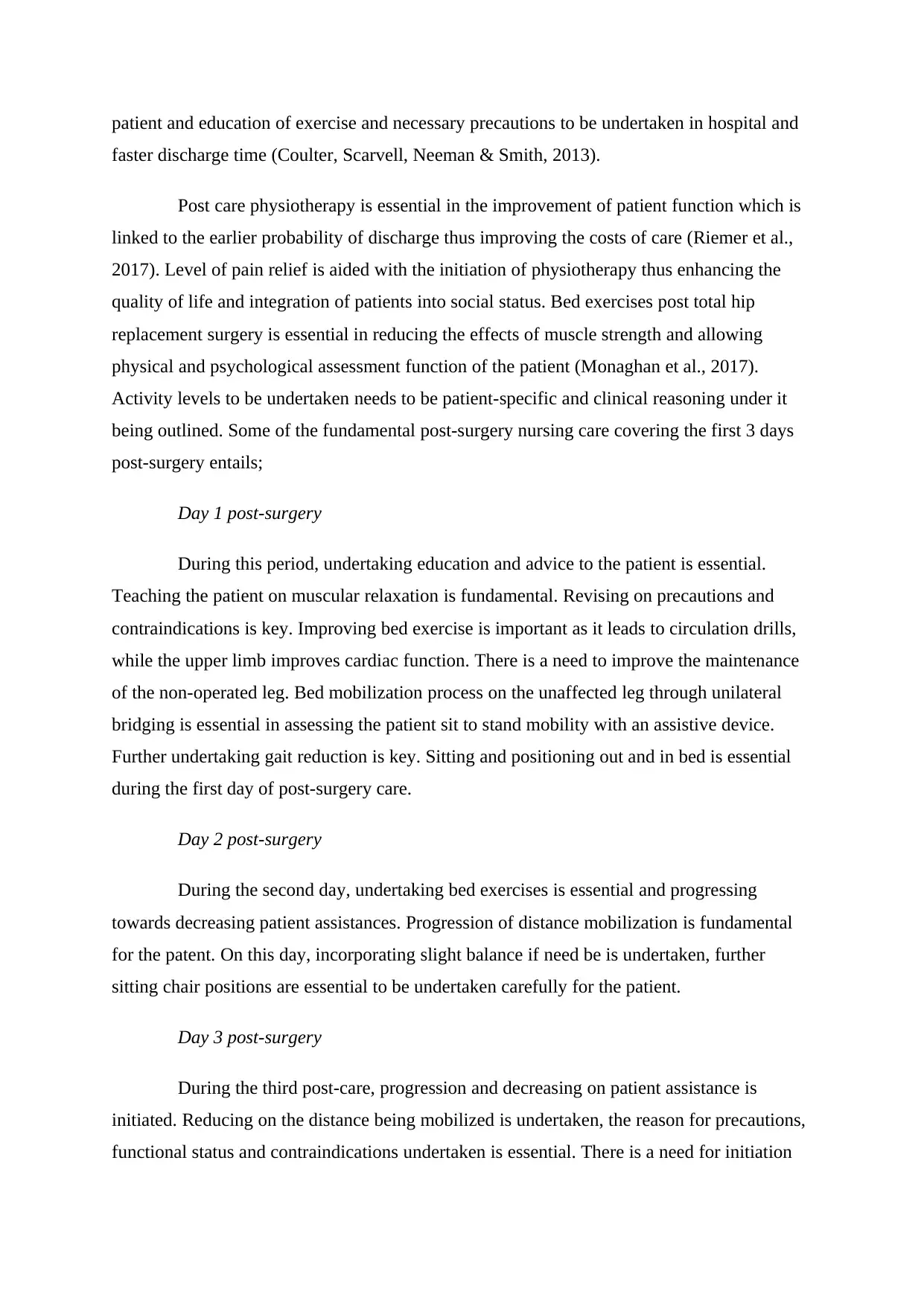
patient and education of exercise and necessary precautions to be undertaken in hospital and
faster discharge time (Coulter, Scarvell, Neeman & Smith, 2013).
Post care physiotherapy is essential in the improvement of patient function which is
linked to the earlier probability of discharge thus improving the costs of care (Riemer et al.,
2017). Level of pain relief is aided with the initiation of physiotherapy thus enhancing the
quality of life and integration of patients into social status. Bed exercises post total hip
replacement surgery is essential in reducing the effects of muscle strength and allowing
physical and psychological assessment function of the patient (Monaghan et al., 2017).
Activity levels to be undertaken needs to be patient-specific and clinical reasoning under it
being outlined. Some of the fundamental post-surgery nursing care covering the first 3 days
post-surgery entails;
Day 1 post-surgery
During this period, undertaking education and advice to the patient is essential.
Teaching the patient on muscular relaxation is fundamental. Revising on precautions and
contraindications is key. Improving bed exercise is important as it leads to circulation drills,
while the upper limb improves cardiac function. There is a need to improve the maintenance
of the non-operated leg. Bed mobilization process on the unaffected leg through unilateral
bridging is essential in assessing the patient sit to stand mobility with an assistive device.
Further undertaking gait reduction is key. Sitting and positioning out and in bed is essential
during the first day of post-surgery care.
Day 2 post-surgery
During the second day, undertaking bed exercises is essential and progressing
towards decreasing patient assistances. Progression of distance mobilization is fundamental
for the patent. On this day, incorporating slight balance if need be is undertaken, further
sitting chair positions are essential to be undertaken carefully for the patient.
Day 3 post-surgery
During the third post-care, progression and decreasing on patient assistance is
initiated. Reducing on the distance being mobilized is undertaken, the reason for precautions,
functional status and contraindications undertaken is essential. There is a need for initiation
faster discharge time (Coulter, Scarvell, Neeman & Smith, 2013).
Post care physiotherapy is essential in the improvement of patient function which is
linked to the earlier probability of discharge thus improving the costs of care (Riemer et al.,
2017). Level of pain relief is aided with the initiation of physiotherapy thus enhancing the
quality of life and integration of patients into social status. Bed exercises post total hip
replacement surgery is essential in reducing the effects of muscle strength and allowing
physical and psychological assessment function of the patient (Monaghan et al., 2017).
Activity levels to be undertaken needs to be patient-specific and clinical reasoning under it
being outlined. Some of the fundamental post-surgery nursing care covering the first 3 days
post-surgery entails;
Day 1 post-surgery
During this period, undertaking education and advice to the patient is essential.
Teaching the patient on muscular relaxation is fundamental. Revising on precautions and
contraindications is key. Improving bed exercise is important as it leads to circulation drills,
while the upper limb improves cardiac function. There is a need to improve the maintenance
of the non-operated leg. Bed mobilization process on the unaffected leg through unilateral
bridging is essential in assessing the patient sit to stand mobility with an assistive device.
Further undertaking gait reduction is key. Sitting and positioning out and in bed is essential
during the first day of post-surgery care.
Day 2 post-surgery
During the second day, undertaking bed exercises is essential and progressing
towards decreasing patient assistances. Progression of distance mobilization is fundamental
for the patent. On this day, incorporating slight balance if need be is undertaken, further
sitting chair positions are essential to be undertaken carefully for the patient.
Day 3 post-surgery
During the third post-care, progression and decreasing on patient assistance is
initiated. Reducing on the distance being mobilized is undertaken, the reason for precautions,
functional status and contraindications undertaken is essential. There is a need for initiation
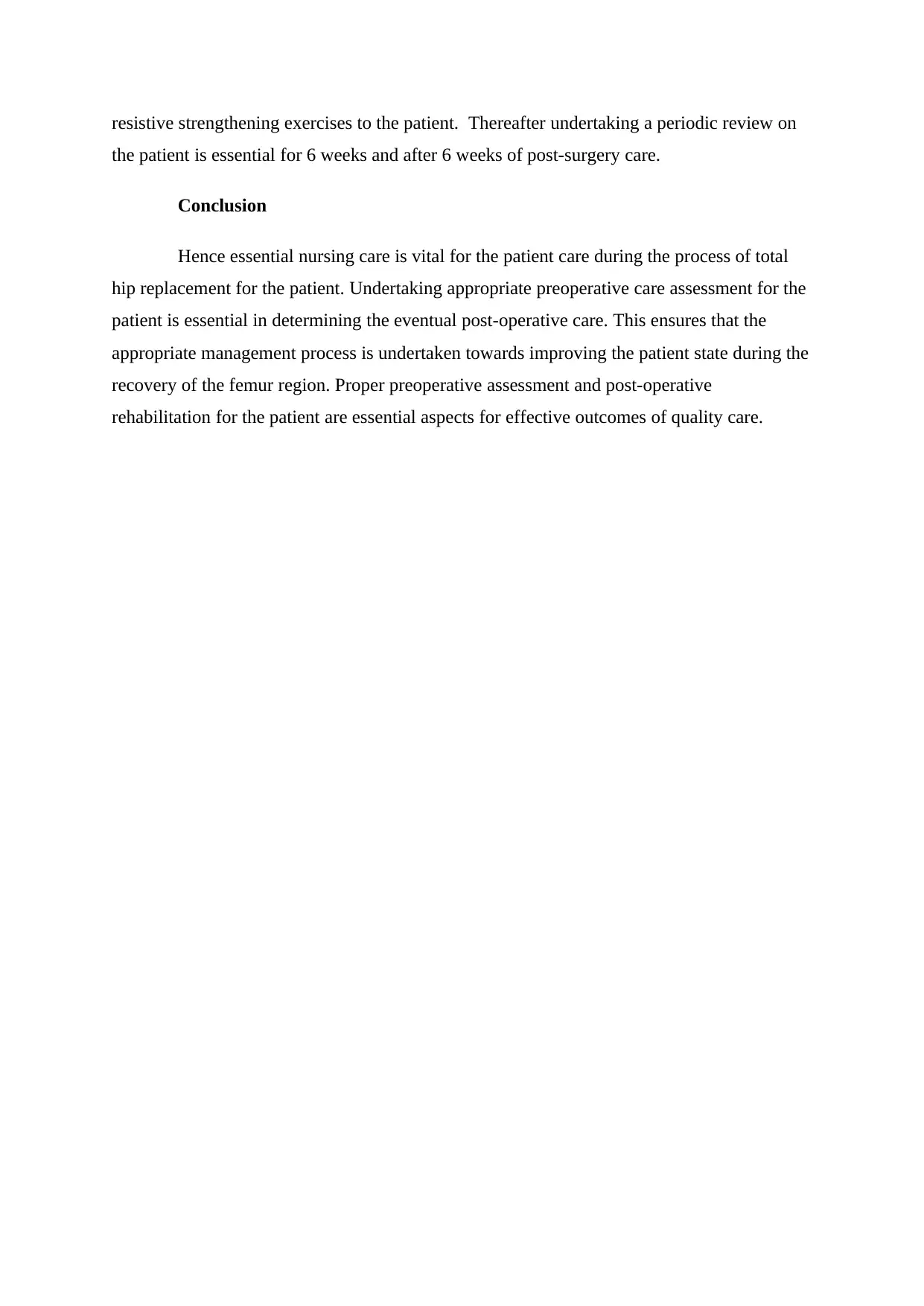
resistive strengthening exercises to the patient. Thereafter undertaking a periodic review on
the patient is essential for 6 weeks and after 6 weeks of post-surgery care.
Conclusion
Hence essential nursing care is vital for the patient care during the process of total
hip replacement for the patient. Undertaking appropriate preoperative care assessment for the
patient is essential in determining the eventual post-operative care. This ensures that the
appropriate management process is undertaken towards improving the patient state during the
recovery of the femur region. Proper preoperative assessment and post-operative
rehabilitation for the patient are essential aspects for effective outcomes of quality care.
the patient is essential for 6 weeks and after 6 weeks of post-surgery care.
Conclusion
Hence essential nursing care is vital for the patient care during the process of total
hip replacement for the patient. Undertaking appropriate preoperative care assessment for the
patient is essential in determining the eventual post-operative care. This ensures that the
appropriate management process is undertaken towards improving the patient state during the
recovery of the femur region. Proper preoperative assessment and post-operative
rehabilitation for the patient are essential aspects for effective outcomes of quality care.
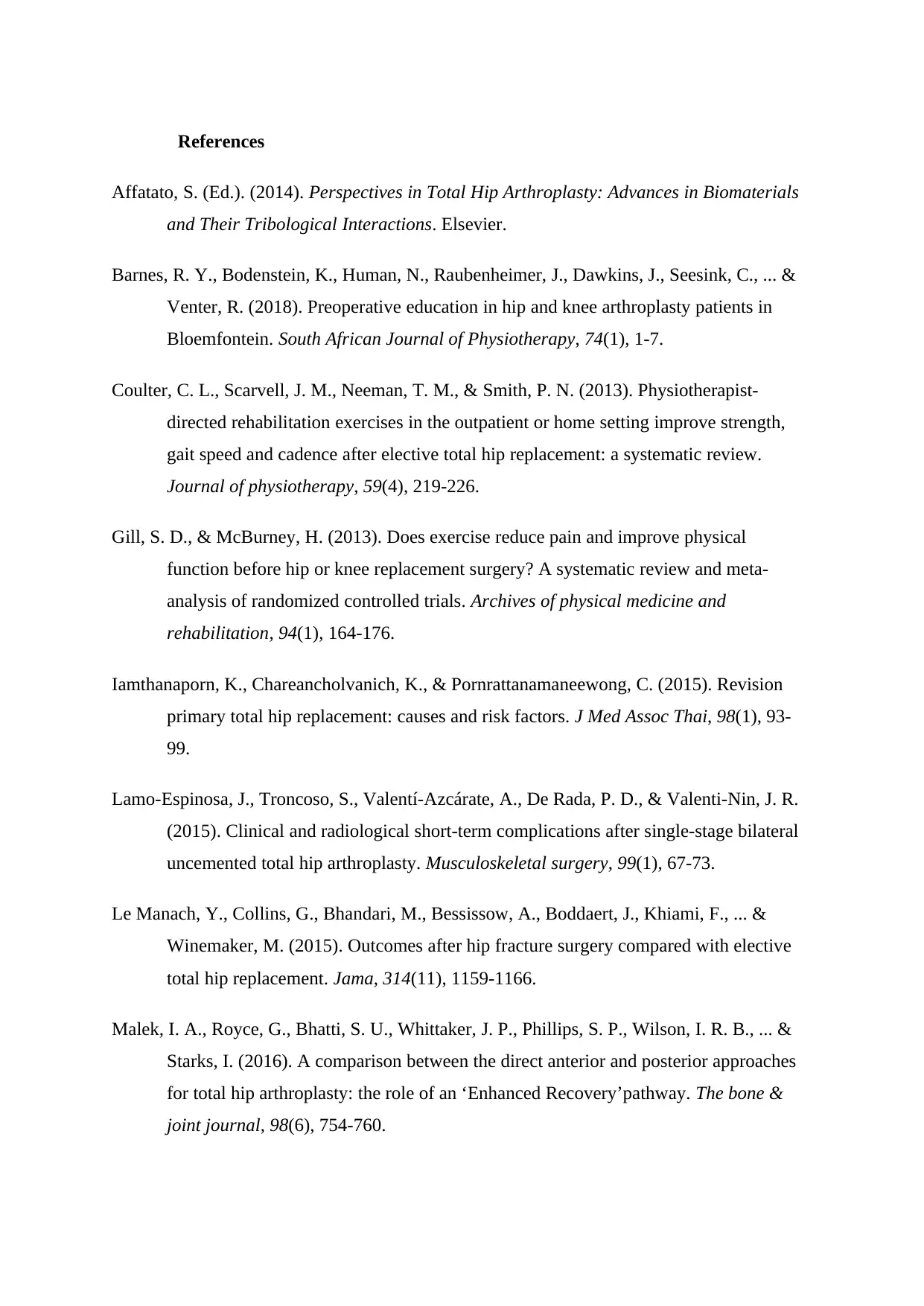
References
Affatato, S. (Ed.). (2014). Perspectives in Total Hip Arthroplasty: Advances in Biomaterials
and Their Tribological Interactions. Elsevier.
Barnes, R. Y., Bodenstein, K., Human, N., Raubenheimer, J., Dawkins, J., Seesink, C., ... &
Venter, R. (2018). Preoperative education in hip and knee arthroplasty patients in
Bloemfontein. South African Journal of Physiotherapy, 74(1), 1-7.
Coulter, C. L., Scarvell, J. M., Neeman, T. M., & Smith, P. N. (2013). Physiotherapist-
directed rehabilitation exercises in the outpatient or home setting improve strength,
gait speed and cadence after elective total hip replacement: a systematic review.
Journal of physiotherapy, 59(4), 219-226.
Gill, S. D., & McBurney, H. (2013). Does exercise reduce pain and improve physical
function before hip or knee replacement surgery? A systematic review and meta-
analysis of randomized controlled trials. Archives of physical medicine and
rehabilitation, 94(1), 164-176.
Iamthanaporn, K., Chareancholvanich, K., & Pornrattanamaneewong, C. (2015). Revision
primary total hip replacement: causes and risk factors. J Med Assoc Thai, 98(1), 93-
99.
Lamo-Espinosa, J., Troncoso, S., Valentí-Azcárate, A., De Rada, P. D., & Valenti-Nin, J. R.
(2015). Clinical and radiological short-term complications after single-stage bilateral
uncemented total hip arthroplasty. Musculoskeletal surgery, 99(1), 67-73.
Le Manach, Y., Collins, G., Bhandari, M., Bessissow, A., Boddaert, J., Khiami, F., ... &
Winemaker, M. (2015). Outcomes after hip fracture surgery compared with elective
total hip replacement. Jama, 314(11), 1159-1166.
Malek, I. A., Royce, G., Bhatti, S. U., Whittaker, J. P., Phillips, S. P., Wilson, I. R. B., ... &
Starks, I. (2016). A comparison between the direct anterior and posterior approaches
for total hip arthroplasty: the role of an ‘Enhanced Recovery’pathway. The bone &
joint journal, 98(6), 754-760.
Affatato, S. (Ed.). (2014). Perspectives in Total Hip Arthroplasty: Advances in Biomaterials
and Their Tribological Interactions. Elsevier.
Barnes, R. Y., Bodenstein, K., Human, N., Raubenheimer, J., Dawkins, J., Seesink, C., ... &
Venter, R. (2018). Preoperative education in hip and knee arthroplasty patients in
Bloemfontein. South African Journal of Physiotherapy, 74(1), 1-7.
Coulter, C. L., Scarvell, J. M., Neeman, T. M., & Smith, P. N. (2013). Physiotherapist-
directed rehabilitation exercises in the outpatient or home setting improve strength,
gait speed and cadence after elective total hip replacement: a systematic review.
Journal of physiotherapy, 59(4), 219-226.
Gill, S. D., & McBurney, H. (2013). Does exercise reduce pain and improve physical
function before hip or knee replacement surgery? A systematic review and meta-
analysis of randomized controlled trials. Archives of physical medicine and
rehabilitation, 94(1), 164-176.
Iamthanaporn, K., Chareancholvanich, K., & Pornrattanamaneewong, C. (2015). Revision
primary total hip replacement: causes and risk factors. J Med Assoc Thai, 98(1), 93-
99.
Lamo-Espinosa, J., Troncoso, S., Valentí-Azcárate, A., De Rada, P. D., & Valenti-Nin, J. R.
(2015). Clinical and radiological short-term complications after single-stage bilateral
uncemented total hip arthroplasty. Musculoskeletal surgery, 99(1), 67-73.
Le Manach, Y., Collins, G., Bhandari, M., Bessissow, A., Boddaert, J., Khiami, F., ... &
Winemaker, M. (2015). Outcomes after hip fracture surgery compared with elective
total hip replacement. Jama, 314(11), 1159-1166.
Malek, I. A., Royce, G., Bhatti, S. U., Whittaker, J. P., Phillips, S. P., Wilson, I. R. B., ... &
Starks, I. (2016). A comparison between the direct anterior and posterior approaches
for total hip arthroplasty: the role of an ‘Enhanced Recovery’pathway. The bone &
joint journal, 98(6), 754-760.
Paraphrase This Document
Need a fresh take? Get an instant paraphrase of this document with our AI Paraphraser
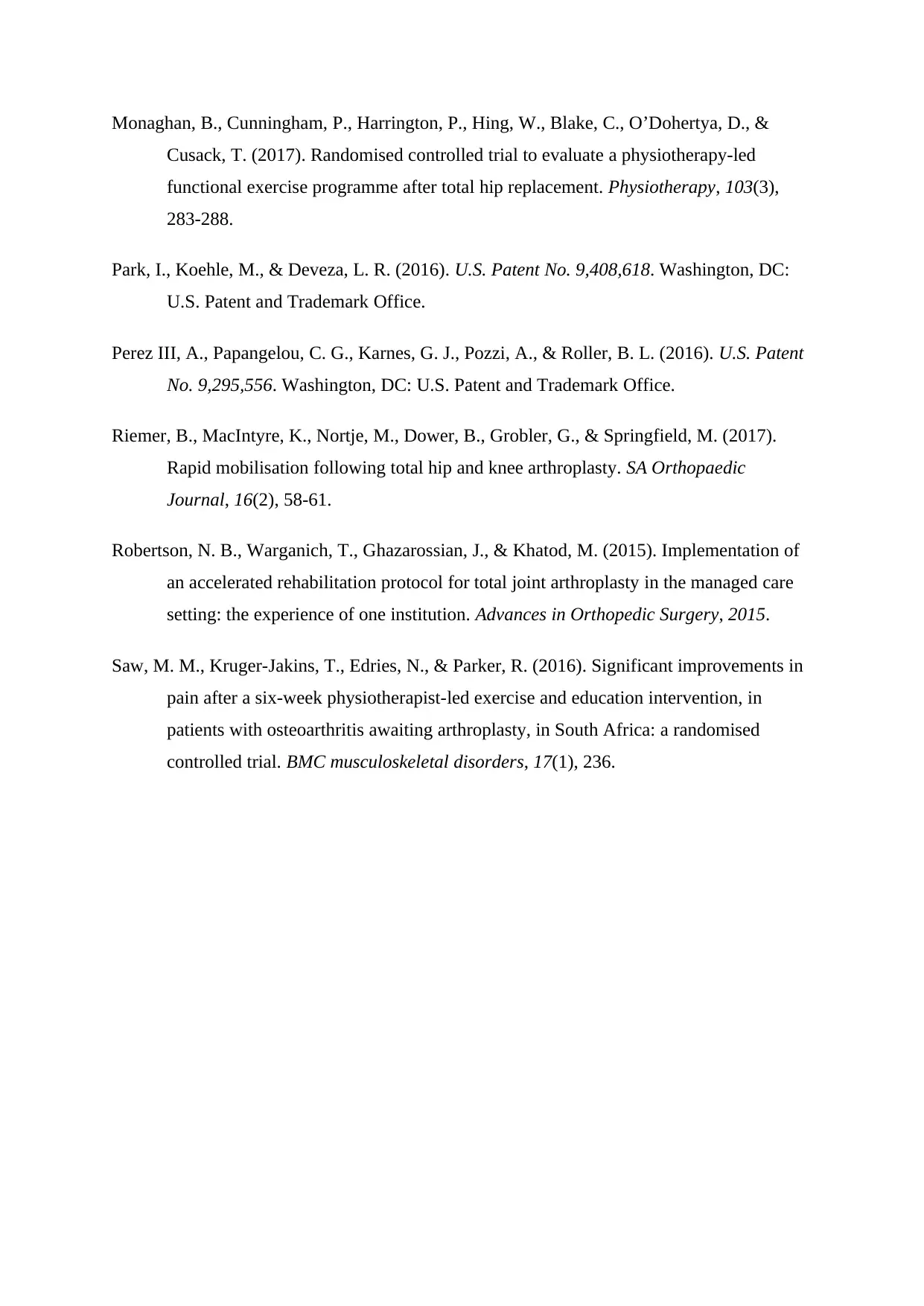
Monaghan, B., Cunningham, P., Harrington, P., Hing, W., Blake, C., O’Dohertya, D., &
Cusack, T. (2017). Randomised controlled trial to evaluate a physiotherapy-led
functional exercise programme after total hip replacement. Physiotherapy, 103(3),
283-288.
Park, I., Koehle, M., & Deveza, L. R. (2016). U.S. Patent No. 9,408,618. Washington, DC:
U.S. Patent and Trademark Office.
Perez III, A., Papangelou, C. G., Karnes, G. J., Pozzi, A., & Roller, B. L. (2016). U.S. Patent
No. 9,295,556. Washington, DC: U.S. Patent and Trademark Office.
Riemer, B., MacIntyre, K., Nortje, M., Dower, B., Grobler, G., & Springfield, M. (2017).
Rapid mobilisation following total hip and knee arthroplasty. SA Orthopaedic
Journal, 16(2), 58-61.
Robertson, N. B., Warganich, T., Ghazarossian, J., & Khatod, M. (2015). Implementation of
an accelerated rehabilitation protocol for total joint arthroplasty in the managed care
setting: the experience of one institution. Advances in Orthopedic Surgery, 2015.
Saw, M. M., Kruger-Jakins, T., Edries, N., & Parker, R. (2016). Significant improvements in
pain after a six-week physiotherapist-led exercise and education intervention, in
patients with osteoarthritis awaiting arthroplasty, in South Africa: a randomised
controlled trial. BMC musculoskeletal disorders, 17(1), 236.
Cusack, T. (2017). Randomised controlled trial to evaluate a physiotherapy-led
functional exercise programme after total hip replacement. Physiotherapy, 103(3),
283-288.
Park, I., Koehle, M., & Deveza, L. R. (2016). U.S. Patent No. 9,408,618. Washington, DC:
U.S. Patent and Trademark Office.
Perez III, A., Papangelou, C. G., Karnes, G. J., Pozzi, A., & Roller, B. L. (2016). U.S. Patent
No. 9,295,556. Washington, DC: U.S. Patent and Trademark Office.
Riemer, B., MacIntyre, K., Nortje, M., Dower, B., Grobler, G., & Springfield, M. (2017).
Rapid mobilisation following total hip and knee arthroplasty. SA Orthopaedic
Journal, 16(2), 58-61.
Robertson, N. B., Warganich, T., Ghazarossian, J., & Khatod, M. (2015). Implementation of
an accelerated rehabilitation protocol for total joint arthroplasty in the managed care
setting: the experience of one institution. Advances in Orthopedic Surgery, 2015.
Saw, M. M., Kruger-Jakins, T., Edries, N., & Parker, R. (2016). Significant improvements in
pain after a six-week physiotherapist-led exercise and education intervention, in
patients with osteoarthritis awaiting arthroplasty, in South Africa: a randomised
controlled trial. BMC musculoskeletal disorders, 17(1), 236.
1 out of 8
Your All-in-One AI-Powered Toolkit for Academic Success.
+13062052269
info@desklib.com
Available 24*7 on WhatsApp / Email
![[object Object]](/_next/static/media/star-bottom.7253800d.svg)
Unlock your academic potential
© 2024 | Zucol Services PVT LTD | All rights reserved.



